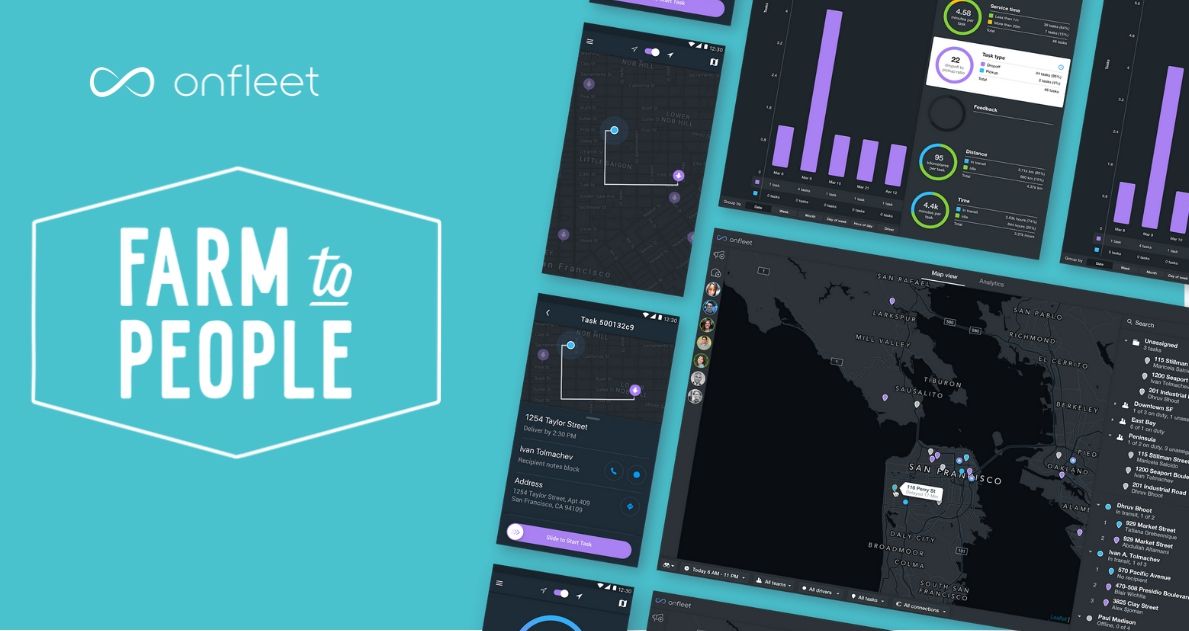
As delivery grows in demand and availability, the average use case expands beyond the expected and into new, exciting opportunities. For Farm to People, that means being the connection between farm-fresh foods and customers looking for quality ingredients in their kitchens.
Over the last four years, Farm to People has used Onfleet to reinforce its mission of simple, high-quality food delivery, from creating routes and managing drivers to effectively reporting delivery data with visualized metrics.
Our Customer Highlight webinar series continued with Shelby Taylor, Director of Data and Technology at Farm to People, who shared how the grocery delivery company scaled its business with Onfleet. Shelby also explains how route analytics supported her goal of improving customer communication.
Missed this session? Check out the summary below or click here to watch the on-demand recording.
Leveraging Route Analytics
Farm to People delivers to four of New York's five boroughs and parts of New Jersey. As you might expect, it's a landscape rife with logistical hurdles. Shelby explained how her team uses Onfleet’s route optimization to group tasks based on their driver's vehicle capacity and ensure that their route fits within the delivery window.
“We utilize a fleet of drivers that use their own vehicles to deliver our boxes. [...] They show up at our warehouse, pick up their route, and route optimization helps us ensure that the route [will] fit within their delivery window,” she said.
Farm to People’s current backend process
Shelby said a shift in their routing process is coming soon, as Farm to People aims to maximize its benefits from Onfleet after attempting to create its own delivery solution in 2022. The lessons they learned from that experience have led to stronger collaboration between her team and Onfleet’s Customer Success team.
"Onfleet’s [platform] allowed us to grow as we have, especially over the course of the pandemic, very rapidly, and has helped our business scale in a way that other platforms may not have been able to,” Shelby said.
With around 2,500 to 3,000 orders daily, she has prioritized building a solution that minimizes delivery failures and keeps customers happy. Going forward, she said Farm to People plans to integrate Onfleet’s API with its custom enterprise resource planning (ERP) system to automate tasks and data communication.
Farm to People’s updated backend process
Looking back on what she’s learned from four years of routing, both with and without Onfleet, she said that integrating deeper with Onfleet’s API from the start would have allowed them to have "much better and more detailed reporting on, in particular, like how many tasks are failing and why."
Getting Creative with Custom Communications
Later, Shelby discussed how they had to set up custom communications for two partnerships with local hospitals. In addition to the standard 3-hour delivery reminder and delivery completed messages, her team created messages in English and Spanish to make it easier for their customers. "We wanted to make sure that the communication was custom to those different program participants," she said. “We love having that feature.”
Shelby then explained how they used the license plate field to put in a link to a driver's Venmo or Cash App and reference it in the communication to the customer. "It enabled us - a company that wasn't on a technology platform that we could customize at the time - to add that as a feature. I think it's a really creative hack on how to use a particular field that you might not be using at all," she said.
How Onfleet Makes it Easier to Manage Delivery Tasks
Shelby shared her experience learning more about Onfleet’s route analytics tool, which has played a crucial role in her ongoing improvements to Farm to People’s delivery process. To her, it seemed like the perfect tool for businesses in a densely populated area such as New York City.
"We try to do our best with route optimization and our own knowledge of the city and its traffic patterns to route in a way that's going to make it a smooth drive for our driver. But it’s always helpful to see what they actually chose to do in the moment when they encounter these obstacles in real-time,” she said.
Shelby also noted the importance of Onfleet’s new custom success and failure reason feature. "These success and failure reasons that are custom, you can add a ton of them, you can go into great detail, or you can just be generic if you want,” she said.
Finally, Shelby discussed the importance of learning more about the Onfleet platform and what she may have done differently, knowing what she does now. "Just learning more about the Onfleet platform earlier on and [working with Customer Success] for some of these features that can be just turned on, even with the success that we’ve had, I definitely would’ve done [it differently]."
Thank you to Shelby for joining us in this informative session. If you’re interested in the full webinar, click here to check out the entire recording.
Our Customer Highlight webinar series will pick back up with EQ3 on March 16, so register now and subscribe to our newsletter below to stay tuned for new session announcements!
